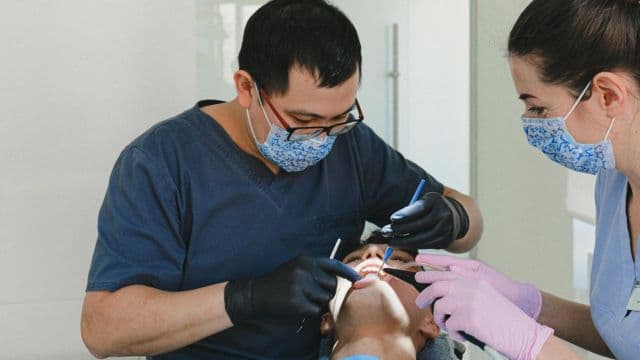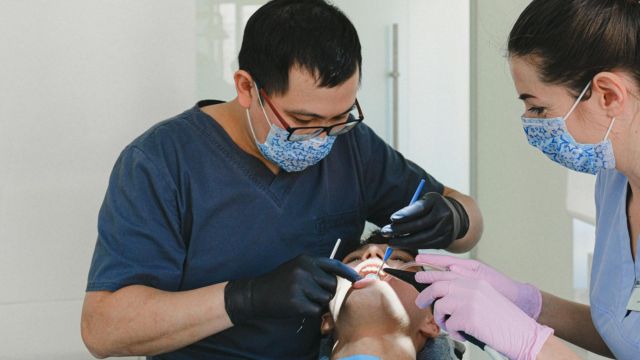This gap in coverage isn't a small oversight—it's a systemic hole that affects millions of Americans who discover the hard way that their healthcare safety net has a gaping tear right where their smile should be protected.
Myth: Original Medicare Covers Routine Dental Care
Truth: Your Cleanings, Fillings, and Extractions Come Out of Your Own Pocket
Medicare Part A and Part B—what's known as Original Medicare—explicitly exclude dental care from coverage. Those six-month cleanings your dentist recommends? Not covered. The filling you need for that cavity? You're paying full price. Even tooth extractions that would prevent infection fall outside Medicare's protective umbrella. The system treats your teeth as luxury items rather than essential components of your overall health, despite mountains of research connecting oral health to heart disease, diabetes, and cognitive decline.
The exclusion runs deeper than most people realize. Medicare won't pay for dentures, the fittings required to make them comfortable, or the adjustments needed as your mouth changes over time. Dental X-rays, root canals, bridges, and crowns all land squarely in the "not covered" category. If you're experiencing jaw pain from TMJ or need periodontal work to save your gums, prepare to open your wallet wide. The only exception arrives when dental work becomes medically necessary as part of another covered procedure—and that bar sits so high that most beneficiaries never clear it.
Myth: Medicare Advantage Plans Always Include Dental
Truth: The Coverage Offered Often Feels Like Window Dressing
Medicare Advantage plans (Part C) frequently advertise dental coverage as a key selling point, plastering it across marketing materials with the enthusiasm of a toothpaste commercial. The reality tastes far less minty fresh. These plans typically offer preventive coverage—cleanings and exams—but cap your annual benefits so low that one major procedure wipes out your entire year's worth of protection. Annual maximums of $1,000 to $1,500 sound adequate until you need a root canal and crown, which can easily exceed $2,000 at your local dentist.
The coverage structure forces you into a strategic game where you must prioritize which dental problems to address and which to postpone. That wisdom tooth that's been bothering you? It might need to wait until next year because you already used this year's maximum on two fillings and a deep cleaning. The waiting periods compound the frustration—many Advantage plans make you wait six months to a year before covering major services, meaning that tooth emergency happening right now won't be covered even though you're paying monthly premiums. Network restrictions add another layer of complexity, limiting you to specific dentists who may or may not be accepting new Medicare patients or conveniently located near your home.
Myth: The Emergency Dental Exception Protects You
Truth: Medicare's Definition of "Emergency" Is Impossibly Narrow
Medicare covers dental care only when it's integral to another covered medical procedure—think jaw reconstruction after cancer surgery or dental work required before a heart valve replacement. The keyword here is "integral," and Medicare interprets it with the strictness of a bouncer at an exclusive club. Your severe tooth infection that's causing fever and facial swelling? Not covered under Original Medicare, even though it could potentially spread to your bloodstream. The broken tooth causing you to avoid eating solid foods? Still doesn't meet the threshold.
This narrow definition creates dangerous situations where people delay necessary dental treatment, hoping their problem resolves itself or waiting until it becomes a true medical emergency. A tooth abscess ignored for weeks can lead to sepsis, which Medicare will cover once you're hospitalized—but by then, you're facing a life-threatening situation that could have been prevented with timely dental intervention. The system essentially incentivizes neglect until problems become catastrophic, turning manageable dental issues into complex medical crises that cost everyone more in the long run.
Myth: You Can Just Buy Standalone Dental Insurance
Truth: Most Plans Designed for Seniors Barely Cover Major Work
Standalone dental insurance marketed to Medicare beneficiaries operates on a model that seems designed to frustrate rather than help. These policies typically charge premiums of $30 to $60 monthly while capping annual benefits at $1,000 to $2,000. Run the math: at $50 monthly, you're paying $600 annually in premiums to access benefits that might only net you an additional $400 to $1,400 in coverage after you've paid your deductibles and co-insurance. The return on investment barely justifies the monthly outlay, especially during years when you need minimal dental work.
Missing tooth clauses present another obstacle that catches people off guard. If you're missing teeth when you enroll, many plans won't cover replacing them for a year or longer. The waiting periods for major services stretch from six months to two years, meaning you need to predict your dental problems far in advance or pay out of pocket anyway. Insurance companies bank on the reality that many beneficiaries will pay premiums for years while using fewer benefits than they contribute, making these plans profitable for insurers but questionable value for consumers seeking meaningful protection against dental costs.
Myth: Medicaid Dental Coverage Works the Same Everywhere
Truth: Your State Determines Whether You Get Help
Dual-eligible beneficiaries—those who qualify for both Medicare and Medicaid—face a confusing patchwork of coverage that varies dramatically by state. Some states offer comprehensive dental benefits through Medicaid that include everything from preventive care to complex restorations. Others limit coverage to emergency extractions only, essentially treating adult dental care as a luxury their budgets can't afford. Moving from Connecticut, which offers robust dental Medicaid benefits, to Texas, which provides minimal coverage, can mean the difference between maintaining your teeth and losing them to untreated decay.
The application process for dual eligibility requires navigating bureaucratic mazes that would challenge even the most organized individuals. Income limits, asset tests, and documentation requirements change based on your location and specific circumstances. Many eligible seniors never access the benefits they qualify for simply because they don't know these programs exist or find the paperwork overwhelming. Community health centers and aging services agencies can help, but finding these resources requires initiative and persistence that's difficult to muster when you're dealing with tooth pain and limited mobility.
Myth: Dental Health Is Separate From Medical Health
Truth: Your Mouth Is the Gateway to Your Body's Overall Wellbeing
The arbitrary separation between dental and medical coverage ignores decades of research showing intimate connections between oral health and systemic conditions. Periodontal disease increases your risk of heart disease, stroke, and diabetes complications. Poor oral health correlates with higher rates of pneumonia in elderly populations, as bacteria from infected gums can be aspirated into the lungs. Tooth loss affects nutrition, as people with missing teeth struggle to eat fresh fruits, vegetables, and proteins essential for maintaining health as they age.
The mental health implications cut just as deep as the physical ones. Adults with poor dental health report higher rates of depression, social isolation, and diminished quality of life. Imagine avoiding restaurants because you're embarrassed about your teeth, or declining social invitations because smiling causes pain or reveals gaps you're ashamed of. The 30-day challenge of building healthy habits becomes infinitely harder when dental pain makes it difficult to focus, or when nutritional limitations prevent you from eating the foods your body needs. Medicare's failure to cover dental care isn't just a billing issue—it's a barrier to the lifestyle improvements and personal growth that support healthy aging.
Myth: Preventive Care Doesn't Matter in Your 70s and 80s
Truth: Regular Dental Maintenance Prevents the Expensive Emergencies
The belief that dental care becomes less important as you age flips reality on its head. Medications common among seniors—blood pressure drugs, antidepressants, antihistamines—cause dry mouth, which accelerates tooth decay and gum disease. Arthritis makes brushing and flossing physically challenging, allowing plaque to build up more rapidly. Cognitive changes can lead to neglected oral hygiene routines. All these factors mean that regular professional dental care becomes more crucial, not less, as you move through your Medicare years.
Skipping those routine cleanings to save money today guarantees more expensive problems tomorrow. A $150 cleaning that catches early decay can prevent a $2,000 crown or extraction down the road. Regular dental visits allow professionals to spot oral cancers early, when they're most treatable. The habit-building strategy that serves you best is scheduling preventive appointments every six months and paying out of pocket for them, treating dental care as a non-negotiable investment in your health rather than an optional expense you can defer. The short-term financial pinch of prevention pales compared to the long-term cost—both financial and physical—of neglect.
Let Go of Assumptions, Take Control of Your Dental Future
The Medicare dental coverage gap isn't going to close on its own, despite periodic political promises. Waiting for the system to change leaves you vulnerable to preventable dental problems that spiral into expensive emergencies. The path forward requires releasing the assumption that someone else will take care of your oral health and accepting that you need a proactive strategy.
Let go of the belief that dental insurance always provides value—sometimes paying out of pocket while negotiating cash discounts saves more than paying premiums for limited coverage. Release the shame around dental problems or gaps in care; focus instead on the actions you can take starting today. Stop waiting for a crisis to force your hand.
Start building a dental emergency fund, even if you can only contribute $25 monthly. Research community health centers and dental schools in your area that offer services at reduced costs. Schedule that cleaning you've been postponing and ask your dentist about payment plans for future work. Investigate whether your income qualifies you for Medicaid dental benefits in your state. These moves—practical, achievable, within your control—matter more than the coverage you wish Medicare provided. That's the mindset shift that protects your smile and your wellbeing for the years ahead.
📚 Sources
1. Centers for Medicare & Medicaid Services. (2024). "Medicare & You 2024: The Official U.S. Government Medicare Handbook."
2. Kaiser Family Foundation. (2023). "Medicare Beneficiaries' Out-of-Pocket Health Care Spending as a Share of Income." KFF Health Reform Analysis.
3. American Dental Association. (2024). "The Oral Health Connection: Systemic Links Between Oral and Overall Health." Journal of the American Dental Association, 155(3).
4. National Institute of Dental and Craniofacial Research. (2023). "Oral Health in America: Advances and Challenges." U.S. Department of Health and Human Services.
🔍 Explore Related Topics










